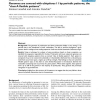20 search results - page 4 / 4 » Indexing DNA Sequences Using q-Grams |
CIKM
2009
Springer
13 years 9 months ago
2009
Springer
A suffix tree is a fundamental data structure for string searching algorithms. Unfortunately, when it comes to the use of suffix trees in real-life applications, the current metho...
BMCBI
2006
13 years 5 months ago
2006
Background: Many vital biological processes, including transcription and splicing, require a combination of short, degenerate sequence patterns, or motifs, adjacent to defined seq...
FSTTCS
2000
Springer
13 years 8 months ago
2000
Springer
In this paper we investigate some properties and algorithms related to a text sparsification technique based on the identification of local maxima in the given string. As the numb...
BMCBI
2005
13 years 5 months ago
2005
Background: Phages, viruses that infect prokaryotes, are the most abundant microbes in the world. A major limitation to studying these viruses is the difficulty of cultivating the...
BMCBI
2005
13 years 5 months ago
2005
Background: The genomes of prokaryotes and lower eukaryotes display a very strong 11 bp periodic bias in the distribution of their nucleotides. This bias is present throughout a g...

